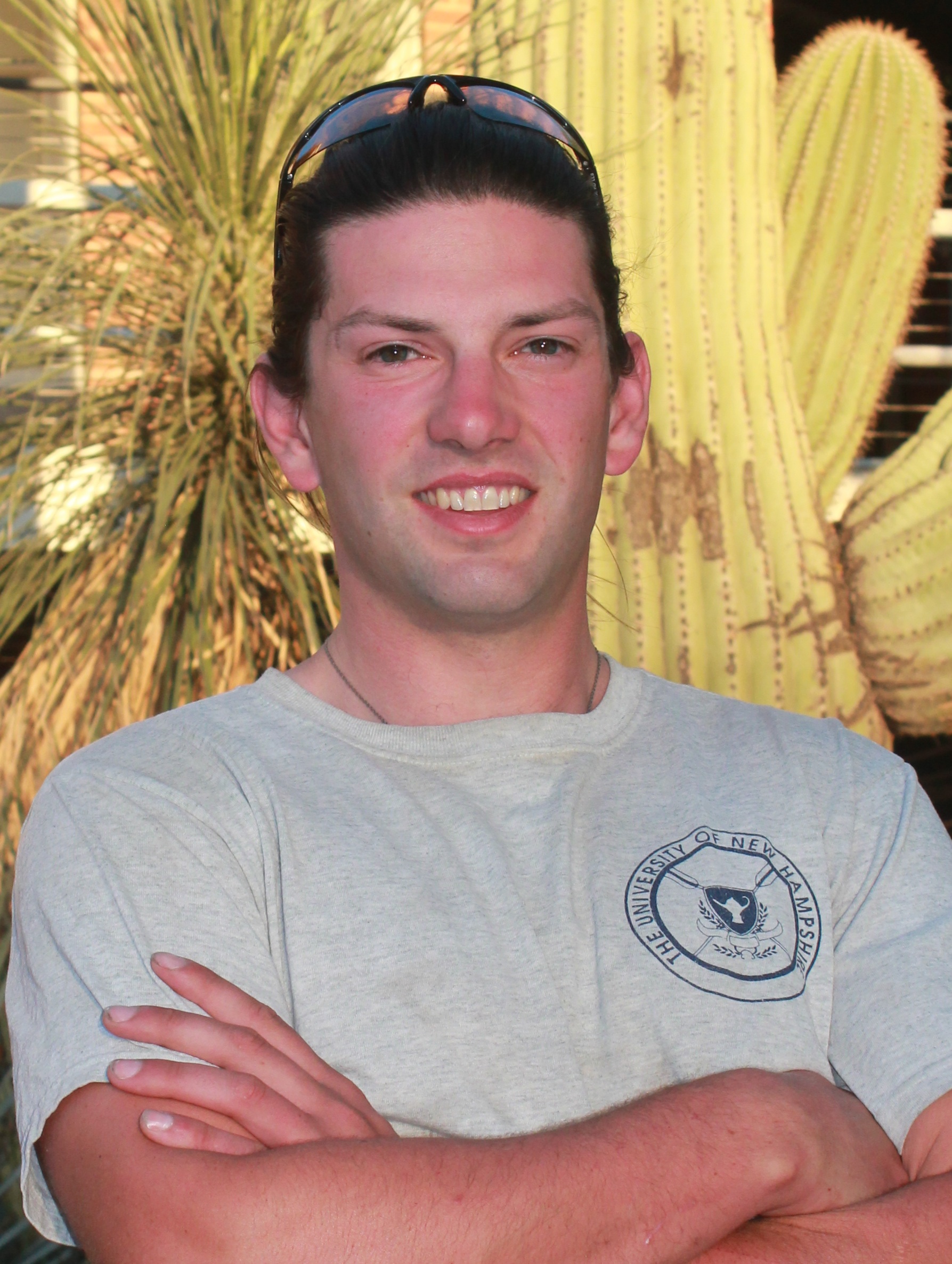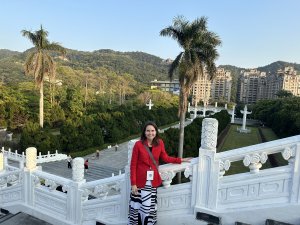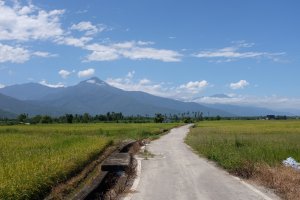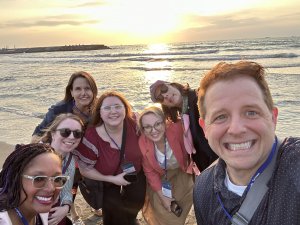If I had a dollar for every perturbed passenger who has shot me a sideways glance as I stared past them from my middle seat out an airplane window, I’m sure I would be able to afford first class and stop making people uncomfortable.
It was raining on the September day in 2017 when I landed at Taoyuan International Airport to begin my Fulbright grant period in Taiwan. When the Boeing 747 dipped below the clouds for a brief moment before touching down, I leaned across the lap of the passenger next to me to peer out the window, only to catch a glimpse of the lush landscape 16th century Portuguese explorers dubbed Ilha Formosa (beautiful island). As an avid enthusiast of 30,000-foot views, I alighted that day unfulfilled.
In the months that followed, I began to explore Taiwan on the ground. I took many day excursions to northern beaches, train rides to cities near Taipei, and even a multi-day hiking trip to Taroko National Park on the east coast. Fresh off a six-month AmeriCorps service term in Arizona spent working on public lands and living out of a pop up tent in the Sonoran Desert, I was conditioned to pack light, be mobile, and hike for hours. But as the year went on and I became accustomed to the conveniences of life in Taipei, my muscles shrank, my calluses softened, and before I knew it I was a full-blown urbanite content to forgo venturing outside the metropolis. All the while my tent collected dust in my dorm room closet.
I’ve been extremely lucky as a graduate student to be funded by Fulbright to live and study here in Taiwan for two years. Perhaps it was the knowledge that I had another year to explore that reduced my inclination to see more of Taiwan in that first year. Maybe my complacency resulted from the comfort of my new daily life, with days now spent conducting research from the cool confines of an air-conditioned library rather than building trails under the hot desert sun. Whatever the reason, though I had thoroughly explored the monuments and back alleys of the capital city and made many friends there, at the end of my first year the feeling that I had yet to truly experience the diversity of Taiwan’s climate, landscape, and culture persisted.
The second time I flew into Taoyuan Airport a year later, the skies were sunny and clear, and I had the window seat. Departing from Hong Kong, the flight path tracked the entire western coastline of Formosa, from Kaohsiung, past Tainan, Taichung, Hsinchu, and finally descended to Taoyuan with the edifice of Taipei 101 visible in the far-off sienna twilight. For about 45 minutes I was in viewing bliss, taking in the backdrop of the rugged central mountain range that jutted to the clouds like the spine of a sleeping stegosaurus. The alpine green mountains gave way to emerald green hills, and at their base began the coastal plain upon which the vast majority of Taiwan’s 23 million inhabitants live and conduct commerce. The speckled array of structures below conformed to the contours of countless rivers rushing to the ocean.
Looking down upon the verdant island that was to be my home for another year, I felt the urgency to see these places up close. But what would be the best way to experience the multitude of sights Taiwan has to offer while still taking time to enjoy them? A favorite saying of the summer camp director I worked for as a teenager came to mind: “Never run so fast you can’t smell the flowers, never walk so slow you can’t taste the wind.” For me, the mode of transportation typifying this philosophy was never in doubt. As I gazed down from my window seat, I promised myself to circumnavigate the island by bicycle.
Many regard Taiwan as the cycling capital of Asia. The bicycle industry has been integral to the economy for decades, and today, domestic companies like Giant and Merida account for a sizable share of the global mid to high-end bicycle market. The island also attracts riders from around the world for its beauty and well-established road infrastructure. In 2015, a 968-kilometer (601-mile) round-island route was completed and has grown in popularity since. So with this goal in mind, I invested in a decent bike and started training.
Through the cycling community in Taipei, I’ve made more good friends who also enjoy getting out often on the sprawling network of riverside bike paths and mountain roads in and around the capital. I tried to convince some of my urban riding buddies to join me on the round-island expedition, but since the trip typically takes upwards of ten days, aligning schedules proved difficult. As the Lunar New Year came and went, it seemed that if I were to accomplish this journey in the spring, it would likely be a solo endeavor. That was until two of my best friends from college days at the University of New Hampshire whom I had floated the idea by in the fall messaged me saying they were ready to book a flight and tackle the Tour de Taiwan! We marked a 10-day window in March to attempt the ride, and reserved some Giant rental bikes.
After an early evening of sipping bubble tea and perusing a night market to acclimate them the night they arrived, the three of us setoff on six wheels from my downtown apartment the next day, embarking on our counterclockwise journey around the island. Spirits were high as we broke out of the Taipei suburbs and bobbed and weaved through foothill passes on the northwest coast. We had been rowing teammates in college, so naturally that friendly competitiveness soon came out in races up early accents. But fresh legs and memories of our fitness glory days would soon lead us astray. Our overzealous attitude resulted in a plan to blaze down the densely populated coastal plain I had seen from the air with back-to-back 100-mile days. The rationale for frontloading mileage was based on the assumption that our 20-something-year-old bodies would adapt quickly, and by the time we rolled into the southernmost surfing town of Kenting we would have our cycling legs beneath us. This was not to be.
Our cycling legs eluded us the entire way. Though the coastal plain road was so flat that a marble placed on its surface wouldn’t roll, the intense sun beating down on us as we crossed the Tropic of Cancer soon sapped our energy and scorched our pasty white New England skin. As an economics major, it was fascinating to see the industry along this stretch that fueled Taiwan’s miracle growth. The price paid for this development lesson was a coating of soot from a concoction of fumes that caked our reddening exposed arms and necks. By the time we reached the outskirts of the second largest city Kaohsiung on the back of the successive century-mile lengths, we were spent. I feared my friends regretted voyaging halfway around the world for a cycling trip that thus far had yielded more pain than pleasure.
But in spite of the sunburn and soreness, we laughed in the face of misery. One uplifting constant throughout was the kindness and encouragement we were met with from every Taiwanese person we encountered (and every is not an exaggeration). My residency here had made me start to take such overt hospitality for granted, but seeing the faces of my two compatriots as they discovered this collective cordiality for themselves was special. Whether it was from a hardened old man hauling an overflowing crate of guavas bungeed to the rack of his rusty steel bicycle who kept pace with us for miles on the flats, flashing a toothless smile and thumbs up each time we’d draw even; or from the noodle shopkeeper who insisted we try all the sauces he had to offer, especially one that, “is used in Italian cooking” which we determined to be Heinz ketchup; or from a young woman at our hostel who herself was cycling the same route and taught my friends the island’s signature phrase of encouragement: jiāyóu (literally translated to, “Add oil,” but figuratively meaning, “You can do it!”), the kind-heartedness of Taiwan’s people really made a mark on them during this first stretch of our trip, even if the scenery did not.
But as we would soon discover, the road ahead abounded in natural beauty. South of Kaohsiung, the industrial and urban landscape gave way to jungle-covered mountains on our left that met golden beaches and the foaming sea to our right. We stopped in the vacation haven of Kenting on the southern peninsula for a much-needed rest day. There, I was humbled in Chinese chess by our hostel owner who shared with me some of his tricks, we visited a “natural hot spring” that turned out to be an unglamorous old man’s bathhouse, and we watched the sunset over beers with surfers on the beach.
After recuperating and rounding the island’s southern tip, the ride back up the rugged and sparsely populated east coast involved much more uphill climbing. But the scenery was so picturesque, and the air so clean, that we were happy to take this tradeoff. This was the Taiwan from the brochure, and the type of riding my friends had envisioned before arriving.
We slept in hostels for half of eight total nights on the road, and stayed with friends and acquaintances I knew along the route the other four. The Fulbright community came in handy, as English teaching assistants dispersed around the island were more than willing to put us up for a night and show us around their neighborhoods. Another of our hosts was a congenial aboriginal woman and her family whom I had met the year prior through a fellow Fulbright master’s student, who herself had become akin to an adopted daughter. Ayí’s (auntie’s) home is tucked away in a gorgeous river valley just inland from the ocean in the northeastern part of Taiwan. This was the last night of our trip, and for all of us our stay here was the highlight. After a hot shower and delicious home cooked meal, Ayí busted out the karaoke machine. She, her elderly but feisty aunt, her daughter and daughter’s friend, and the three of us traded off singing duets to classic Taiwanese love ballots and Lady Gaga hits alike deep into the night. It was the perfect cap on an incredible trip, and a night I’m sure we will reminisce about years from now.
It has been a real privilege to call Taiwan home for two years, and to have been afforded the opportunity to intimately acquaint myself with this people and society. The experience has opened my eyes to the vibrancy of a unique culture and democracy that is thriving 12 time zones from my home in the United States. The Taiwanese will always have a special place in my heart for the hospitality and friendship they’ve shown me. I was fortunate to be able to share this welcoming country with two close friends, and I know their experience, though short, also made a lasting impression on them. And now if I am lucky enough to have a window seat on my return flight back to America, I’ll look down on the beautiful island and think to myself that I truly experienced the best it has to offer.





